Are you looking for the best places to visit in Iceland for an upcoming trip? Keep reading, because I’ve got you covered!
If youʻre booking your trip to Iceland last minute, we have you covered. Below are some of the top tours, hotels, and more!
🇮🇸 Popular tours and activities in Iceland:
- Golden Circle day trip from Reykjavik (includes Kerid Crater)
- Jökulsárlón Glacier Lagoon Full-Day Trip (dinner in Vik)
- Blue Lagoon Admission with Transfers (for the bucket list)
🛌 Top places to stay in Iceland:
- Reykjavik Residence Apartment Hotel (Reykjavik)
- Centrum Hotel (Akureyri)
- Post-Plaza Guesthouse (Húsavík)
- Hotel Vík í Mýrdal (Vik)
✈️ Want to get from the airport to Reykjavik hassle-free? Find the best airport transfer option here!
🚗 Looking for the best way to get around Iceland? Click here to check rental car rates for Iceland!
This guide contains the top Icelandic destinations, from waterfalls to beaches to cities… and beyond! Did I miss any amazing places in Iceland? Let me know in the comments!
In this post...
Best Places to Visit in Iceland
1. Gullfoss
One of the most impressive things in Iceland is the Gullfoss (translated to Golden Falls) waterfall on the Hvítá River, 68 miles (110 kilometers) from Reykjavik.
The total height of the waterfall is 104 feet (32 meters), fed by meltwater from the Langjökull glacier. It is naturally divided into two stages, creating a dramatic natural scene, especially during floods.
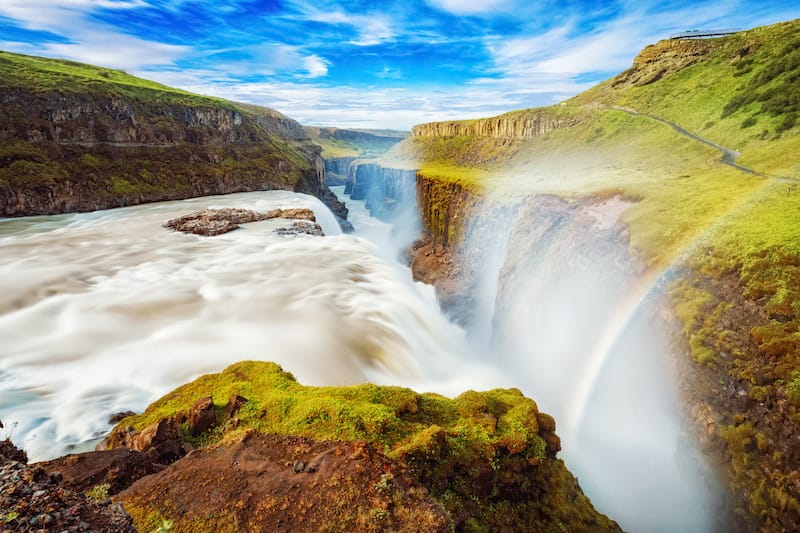
When finished exploring the territory, find Gullfoss Kaffi to stop by for snacks and coffee just a few minutes from the waterfall. Gullfoss is part of the Golden Circle route, which means you can visit Thingvellir and Haukadalur geysers in one day.
If you plan to visit the waterfall in the summer, you can take a daily bus from Reykjavik. In winter, buses are rare, so you can rent a car.
2. Fjallsarlon Glacier Lagoon
Iceland is the land of ice, and you understand it as soon as you visit Fjallsárlón Glacier Lagoon. The iceberg lagoon is located at the southernmost tip of Europe’s biggest glacier.
The best thing about the tour is the close-up views of the Fjallsjokull glacier and melting icebergs.
A zodiac boat ride close to the icebergs is one of the most extreme things to experience. You can also book a helicopter tour around the Fjallsárlón, Jökulsárlón, and Vatnajökull glaciers.
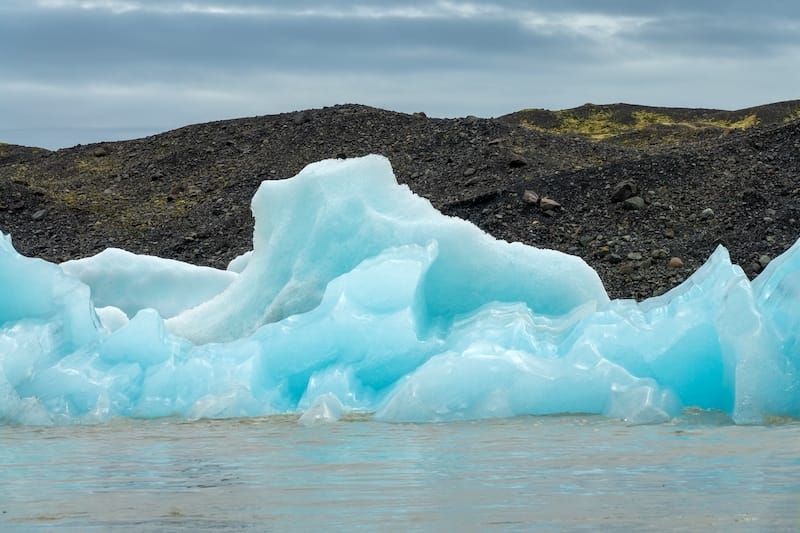
The lagoon is part of Vatnajökull National Park, 230 miles (370 kilometers) from Reykjavik.
You can visit Fjallsárlón Glacier Lagoon all year round, but in the summer, you may see the icebergs glittering under the sun and have a boat ride close to the glacier.
Don’t forget to taste the local food at Fjallsárlón Frost Restaurant, which has views of the lagoon.
3. Lake Mývatn
The Myvatn region, also known as the Diamond Circle, is one of the top places to visit in Iceland for its wonders: Lake Mývatn, Husavik town, Dettifoss Waterfall, and Asbyrgi Canyon.
The main attraction here is Lake Mývatn, a surreal landscape formed by volcanic eruptions. The lake is quite big to walk around, so you can drive all around, stopping at Skútustaðagígar pseudo crater field and lava formations.
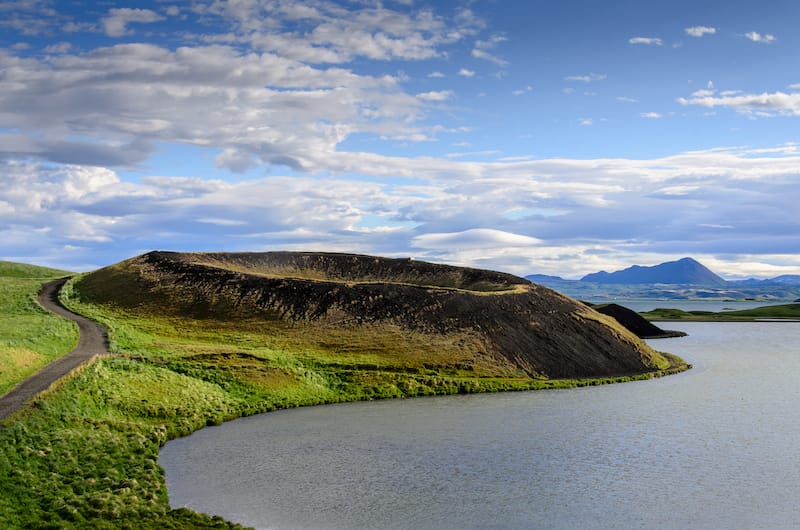
A few miles from Lake Mvatn, you’ll find Myvatn Nature Baths with milky blue water.
The place is known for having one of the hottest pools in northern Iceland. The pools are man-made, but that doesn’t make them less attractive, especially for winter to relax after a long walk.
4. Stakkholtsgja Canyon
Located on your way to Þórsmörk Nature Reserve in southern Iceland, Stakkholtsgja Canyon is a true gem and a magical hiking destination.
You will cross several small streams (the rocks are slippery, so make sure your shoes are appropriate) and high palagonite cliffs, getting narrower to the end.
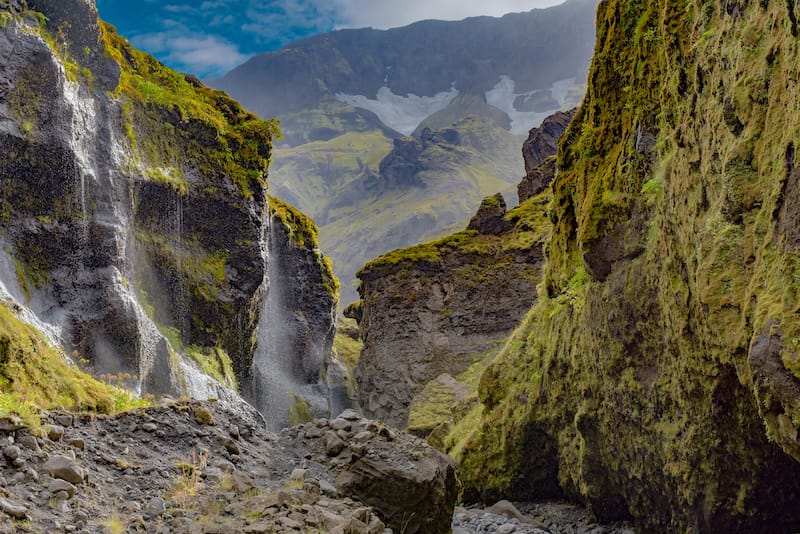
The 1.25-mile (2-kilometer) hike will end with jaw-dropping views of a waterfall cascading down the steep canyon.
If you want an adrenaline rush and extreme views, take a slight left to reach a narrow part of the canyon where two sides of moss-covered cliffs almost touch each other.
Stakkholtsgja Canyon is not accessible in the winter. In August, stream levels are low, and waterfalls are smaller. You can plan your visit in June when streams and waterfalls are full.
5. Reykjavík
Reykjavik is a city full of surprises, with a wealth of sights and activities that will appeal to culture, nature, and nightlife enthusiasts alike.
It is hard to describe the city in a few words, but you can start with Skólavörðustígur Street in downtown Reykjavik, the busiest street with cafes, restaurants, and shops.
Change the city views with Nauthólsvík geothermal beach with an artificial wall, creating a lagoon.
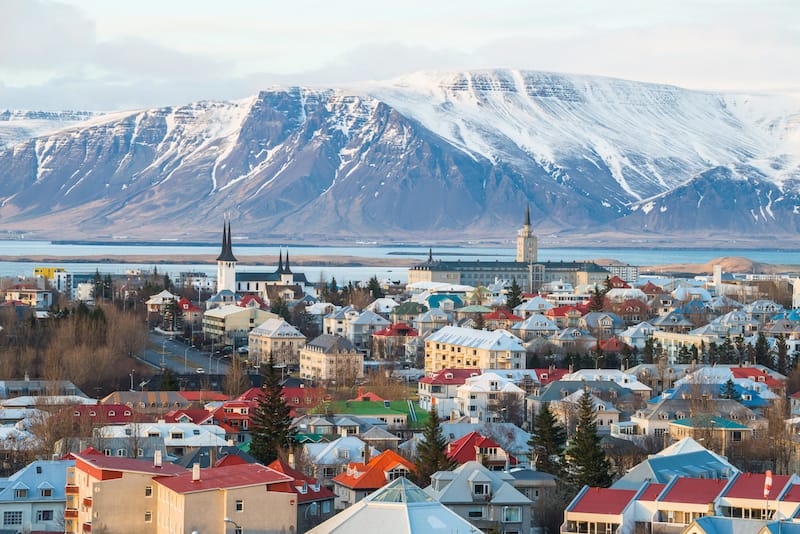
By the way, residents do love spending time in pools and saunas, and you will find a lot of heated swimming pools around Reykjavik.
If you have time, take a half-day whale-watching tour from Reykjavik to see minke and humpback whales, white-beaked dolphins, harbor porpoises, and others.
Also, don’t shy away from visiting Reykjavik in winter. It is magical under a layer of snow (even though the snow seems to stay away when I am there in the winter).
Additional Reykjavik Travel Guides:
6. Djúpalónssandur Beach
Djúpalónssandur is one of the black sand beaches in Iceland with dramatic landscapes, lava formations, and natural pools. The beach is fascinating, but it is not a place for water sports. Warning signs will advise you to enjoy the beauty from a safe distance.
For a short hike, you can take a 0.6-mile (1-kilometer) walk to Dritvik, a neighboring cove with no less impressive lava formations.
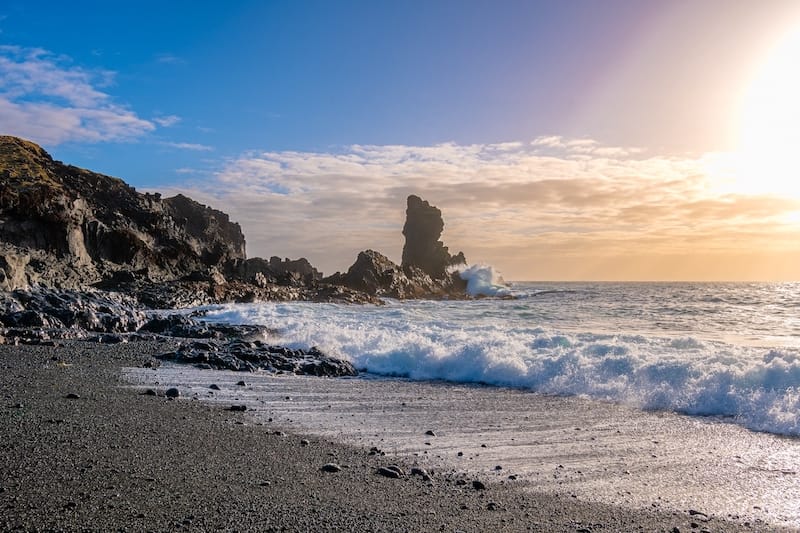
The black pebble beach and the Snæfellsjökull National Park are great for hiking in spring, summer, and fall. When walking to the beach, find four stones next to each other and try to lift them.
The Lifting Stones, or Aflraunasteinar-Steinatök, were used to measure strength and are quite heavy.
7. Fjadrargljufur Canyon
A large, 328-foot (100-meter) deep, 1.24-mile (2-kilometer) long canyon is one of the wonders of southern Iceland. Fjadrargljufur Canyon was created by the erosion of flowing glaciers. Today, the Fjaðrá River runs through the canyon.
It is highly advised to hike along the canyon straight to the Mogarfoss waterfall, a favorite place of photographers.
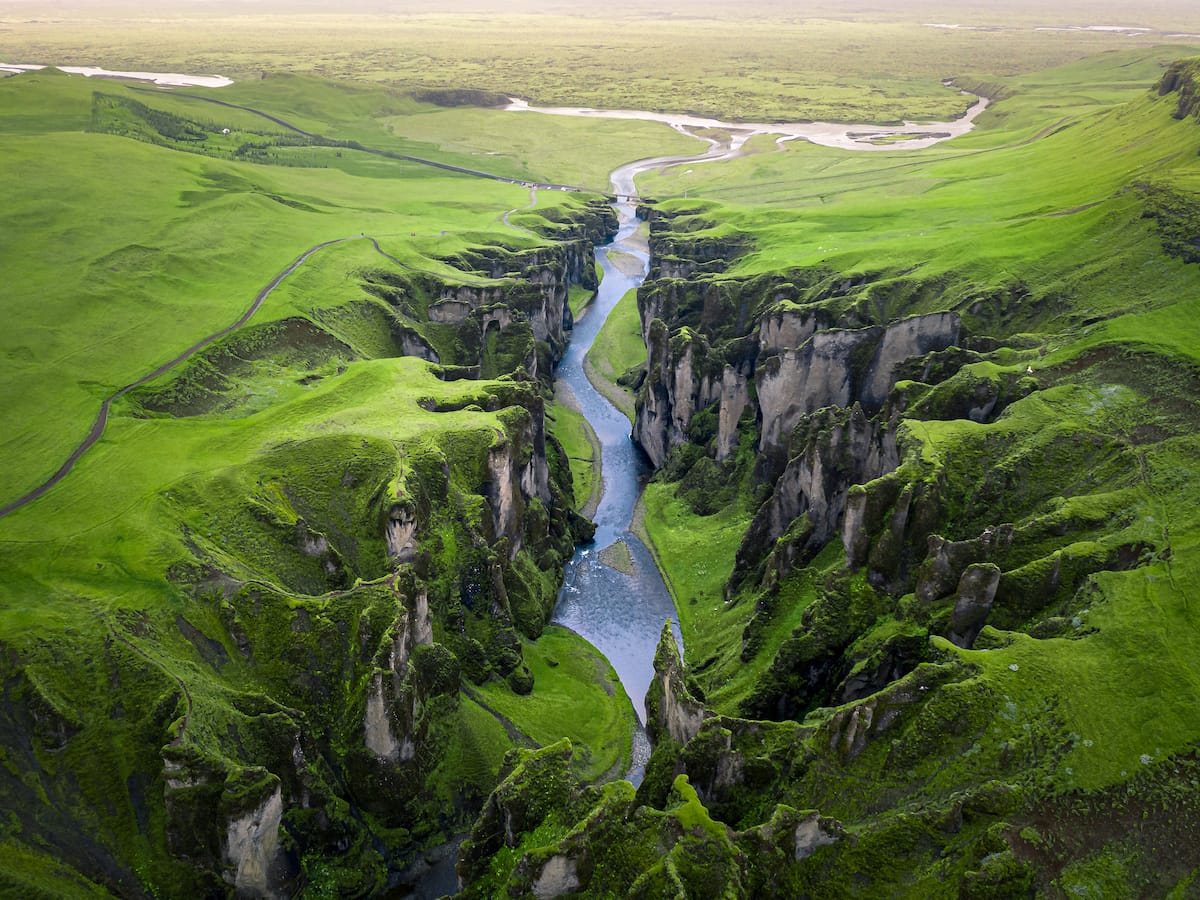
You can either stick to the path along the top of the canyon and stop by observation decks or go down to the bottom. Choose the second option if you are not afraid to get wet, but you will be rewarded with matchless views.
By the way, fans of Game of Thrones may find those scenes familiar; the canyon was used as a location for the scene when Daenerys and Jon flew dragons together for the first time.
You will fall in love with nature, and you can stay longer in one of the nearby guesthouses, like the Hunkubakkar Guesthouse.
8. Þingvellir National Park
Because of its natural beauty, Þingvellir National Park is frequently included in lists of “Top Things to Do in Iceland.” It is an easy stop along Iceland’s Ring Road (and an essential one for history lovers).
The destination is part of the Golden Circle, 25 miles (40 kilometers) from Reykjavik, and features scenery from Game of Thrones.
Start with the Hakid Visitor Center to get all the instructions and information on what to do. Check opening hours because the visitor center has a different schedule depending on the season.
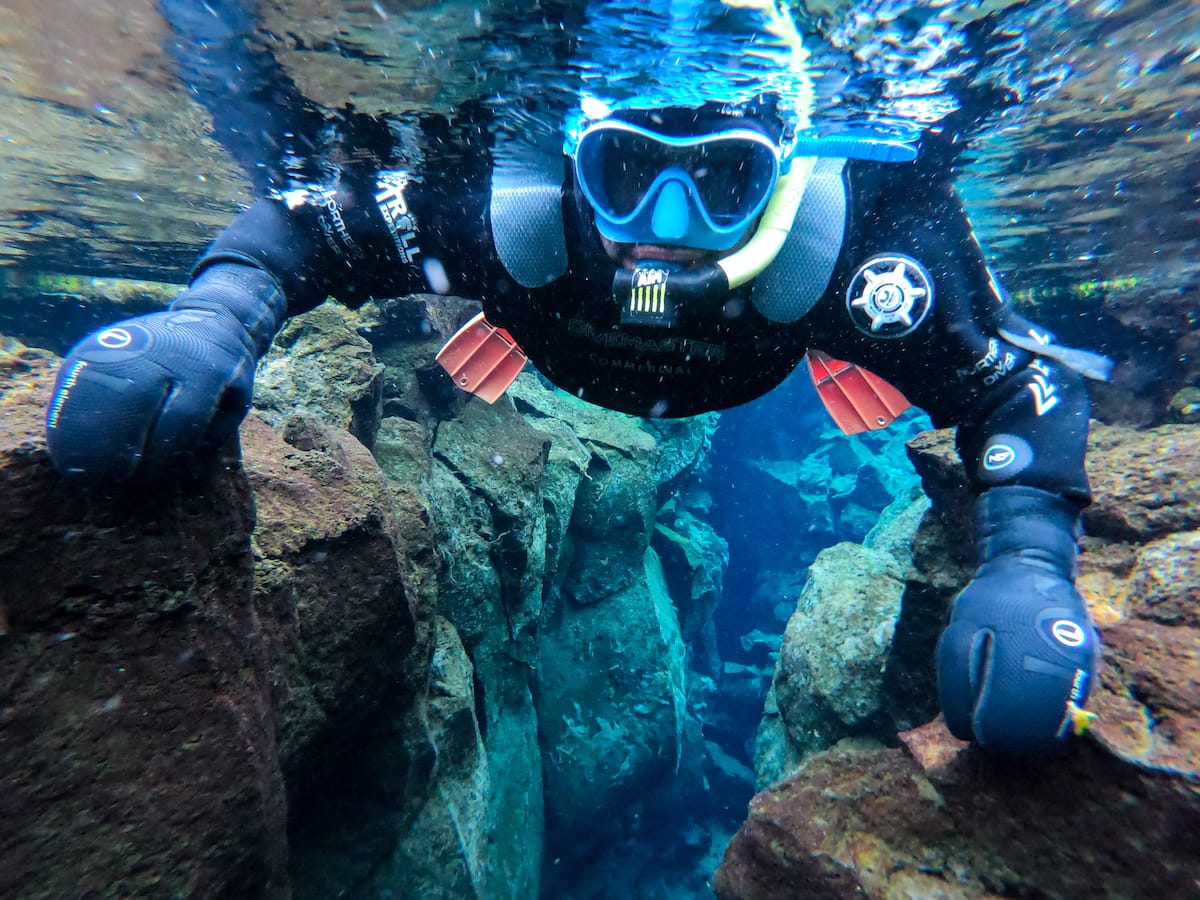
Walking between the continental tectonic plates is the most exciting way to explore Þingvellir. If you have time, dive into the clear spring waters of Silfra Fissure or hike to the Oxararfoss waterfall.
There is no wrong time to visit the park, and every season has its romance. The best months to explore the park without crowds are April, May, September, and October.
Additional Thingvellir National Park Travel Guides:
9. Hafnarhólmi
Whether you are a fan of birdwatching or not, Hafnarhólmi is worth your attention as a unique place to watch the cutest puffins (actually one of the largest colonies of puffins).
Hafnarhólmi is an islet, a grassy rock to view from an observation deck. You can drive there, leave your car in the parking lot, and walk 820 feet (250 meters) to the harbor.
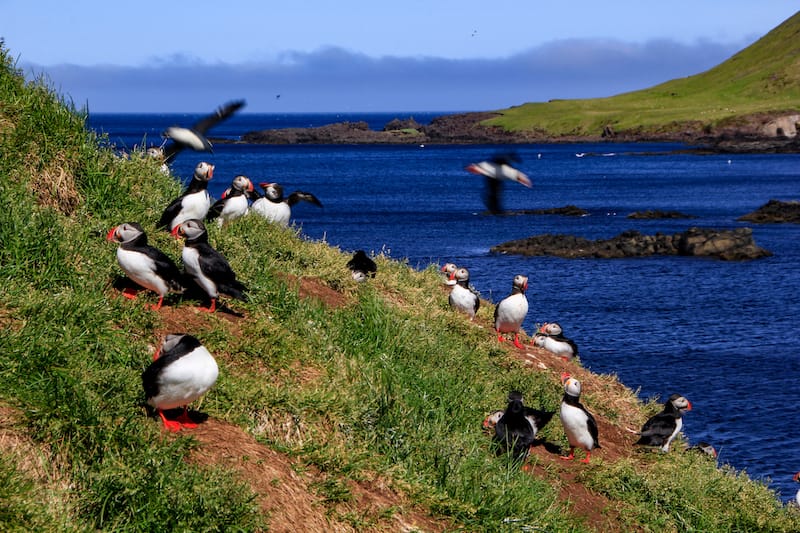
Many stairs lead very close to the birds, giving an unforgettable experience and unparalleled contact. Still, it is forbidden to step on the grass or, in any way, disturb birds.
If you have time, head to the fish factory and enjoy fresh fish soup and Icelandic food at Hafnarhus Café, with panoramic windows overlooking the rocks.
10. Vík
The small town of Vik is one of the most beautiful places in Iceland not to miss. It’s is located on the southern coast, approximately 2.5 hours drive from Reykjavik, and is part of the Ring Road.
The first thing that captures attention is the Reynisfjara Black Sand Beach, dramatically contrasting with the white foam of the waves.
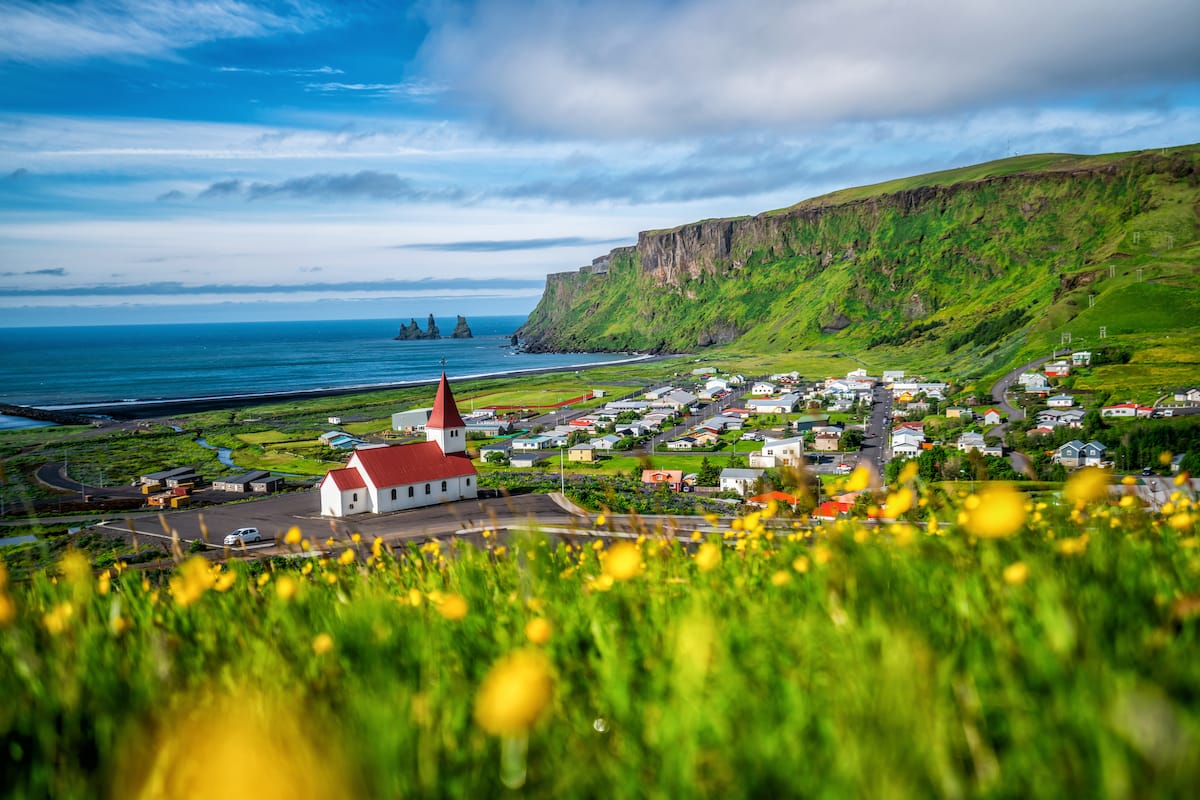
Take a hot coffee from Skool Beans Cafe and enjoy the sound of the waves for a moment.
The beaches of Vik have unique rock formations like Reynisfjall and its neighbors, Reynisfjara and Reynisdrangar, captured in multiple scenes of Game of Thrones.
Another familiar scene is Dyrhólaey, the wave-cut arch that is home to colonies of puffins during summer. Finally, take a 3-hour hike from Vik to Sólheimajökull Glacier to get magnificent views.
11. Studlagil Canyon
There are few places in the world with so many wonders, and Iceland is one of them. Stuðlagil Canyon is a unique valley of basalt formations towering over a vibrant teal glacier river.
Those huge hexagonal columns look almost unrealistic, especially contrasting with the green grass and the glacial waters.
Once a hidden gem of Iceland, the canyon is now rarely empty. The river’s east and west sides are the main viewing points in Studlagil Canyon.
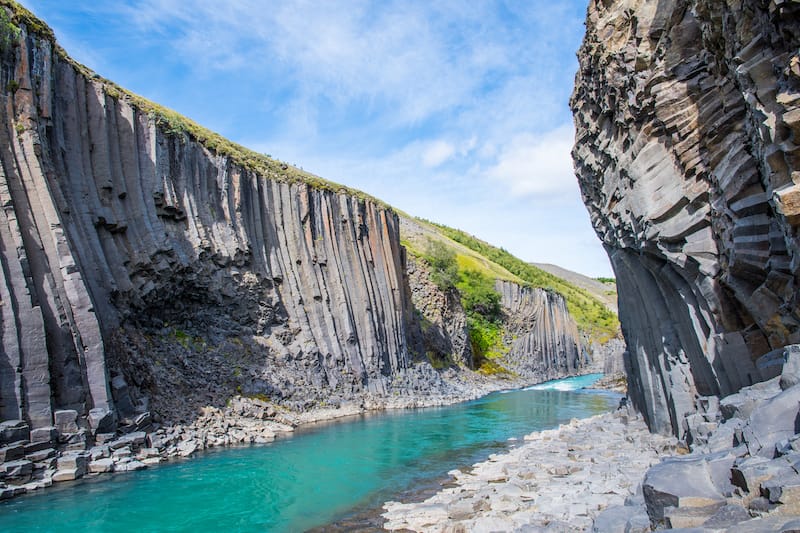
The west entry starts from the parking lot, with a metal staircase leading down to the river. The east side has more impressive views.
The hike (depending on which parking area you stop by) will take you down to the river with giant columns.
12. Holuhraun Lava Field
Holuhraun Lava Field, located north of the Vatnajökull Glacier, is the youngest lava field, formulated after the recent eruption in 2014.
A 6-month-long eruption created a huge lava field—the largest since the 18th century! This lunar-like landscape is located near the Askja crater, which is still active, and the whole territory is quite dangerous.
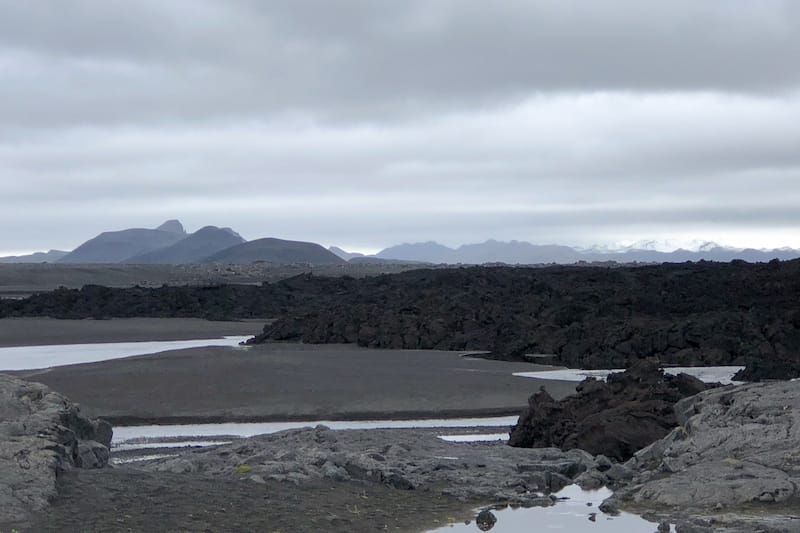
If you are still willing to visit the lava field, you will need a 4×4 vehicle to cross rivers and drive off tracks on the mountain road.
Access to Holuhraun starts from the F910 road. From the north entrance, you will take a 2625-foot (800-meter) loop. Follow the yellow marks to stay safe. From a distance, you can only see lava caves and rock formations.
13. Seljalandsfoss
Iceland is home to countless waterfalls, and each one is more breathtaking than the last. Seljalandsfoss waterfall is unique, as you can walk behind the cascading water.
If you follow the path from the cliff base, you’ll be rewarded with an up-close view of this natural wonder.
The waterfall in south Iceland, filled with glacier water, cascades down from 197 feet (60 meters) and flows down to the Atlantic Ocean.
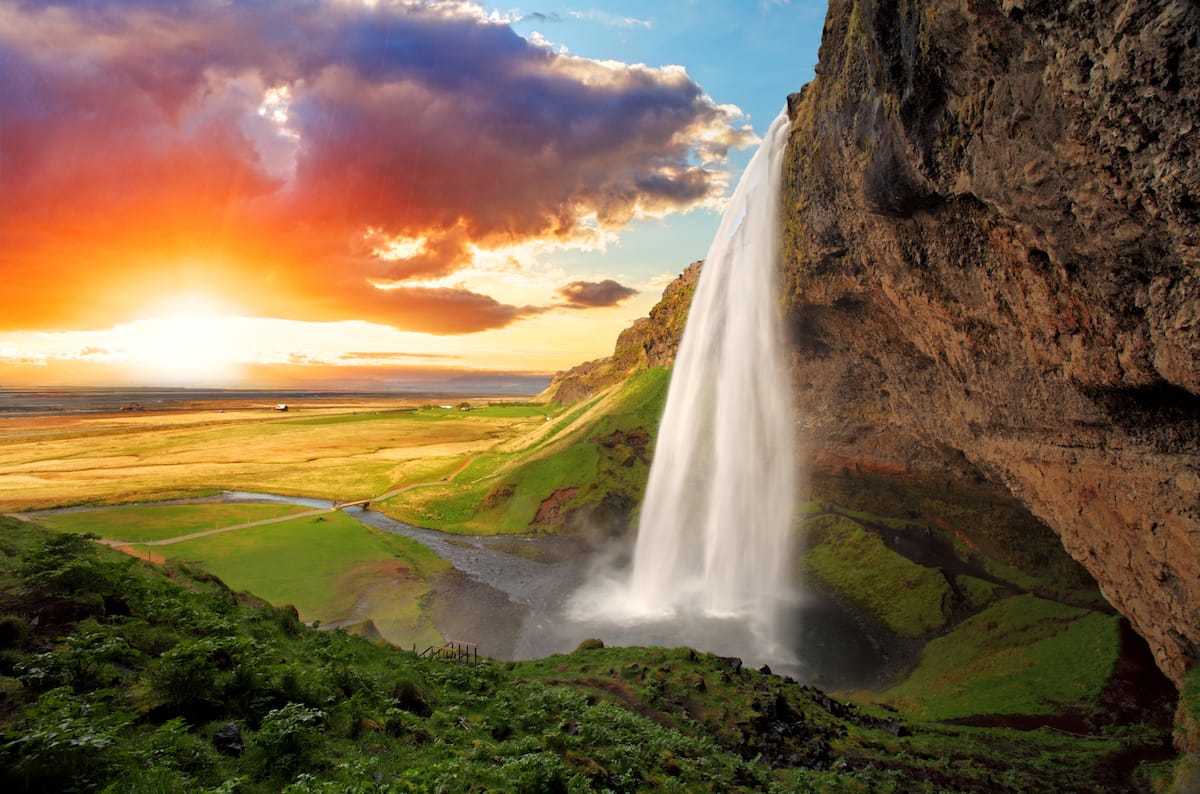
Seljalandsfoss is equally impressive in winter and summer. Just make sure you have shoes with a strong grip or crampons and waterproof outerwear to go beyond the waterfall.
Between September and April, Seljalandsfoss is mostly visited at night for potential aurora shows. In the area, you can find a small gift shop and a food truck with snacks.
14. Hrunalaug Hot Spring
Hrunalaug Hot Spring is one of Iceland’s many wonders. It is not as well known as other hot springs and is less crowded as a result. It is located in the small town of Flúðir and is part of the Golden Circle.
An easy hike from the parking lot takes you straight to a small pool. Unlike other hot springs, the water in Hrunalaug can get up to 104F (40C), making it the perfect place to warm up for a bit.
You are only permitted a maximum time of 1.5 hours in the spring.
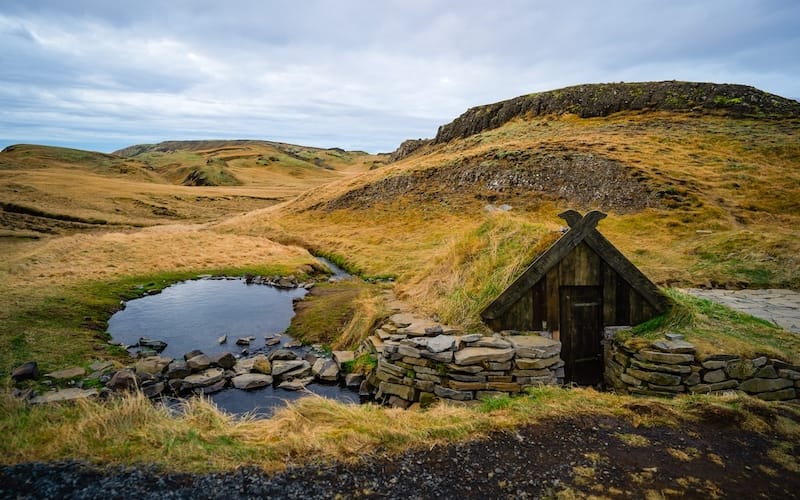
The hot springs are located on private land, so you will be asked to pay a small fee of 2000 ISK (about $14.50), and they now take cards as well as cash. They have recently built two toilets nearby, and the facilities are evolving year after year.
You can purchase coffee, soda, and sweets before or after your dip!
15. Vestmannaeyjar
Vestmannaeyjar, or the Westman Islands, is an archipelago of 15 islands. The most recent one emerged from the ocean in 1963, and people witnessed it.
The first place to visit is Heimaey Island, the largest one with the only Vestmannaeyjarbær town. Every summer, the island becomes home to millions of migrating puffins.
One of the “not-to-be-missed” things on Vestmannaeyjar is the Eldfell mountain hike, a 721-foot (220-meter) trail to the eruption edge.
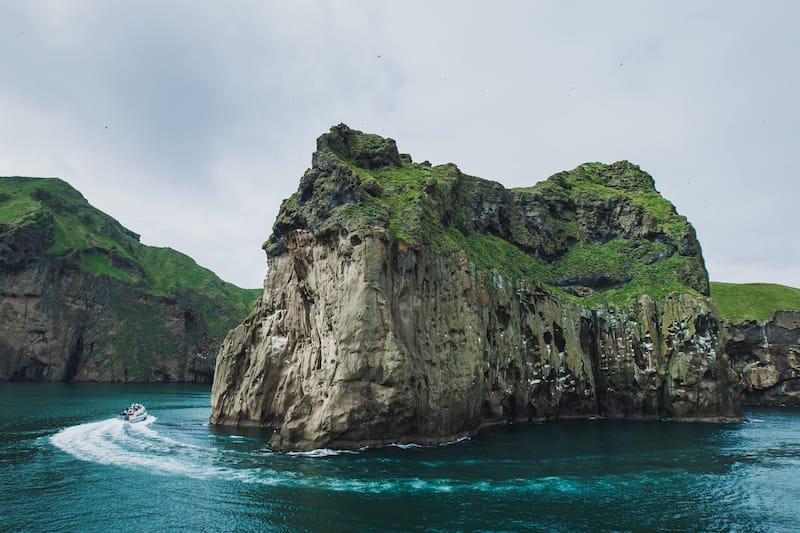
Once at the top, you will see a surreal panorama of lava chunks and red hues contrasting with green islands popping up from the water. Sit on the ground, and you will feel it is still warm.
Spare time to explore all the 15 islands on the boat to see more in less time.
Finally, remember these names to include in your itinerary: the Brothers Brewery to taste the local brew, Slippurinn—one of the highest-rated restaurants, and Joy for quick snacks.
16. Víti Maar
Viti Maar is a small geothermal lake formed in the crater of the volcano Krafla. According to legend, hell (Víti) is located under volcanoes.
The lake is 108 feet (33 meters) deep and has water that changes color depending on the weather. It frequently appears to be an emerald gem surrounded by jet-black volcanic sand.
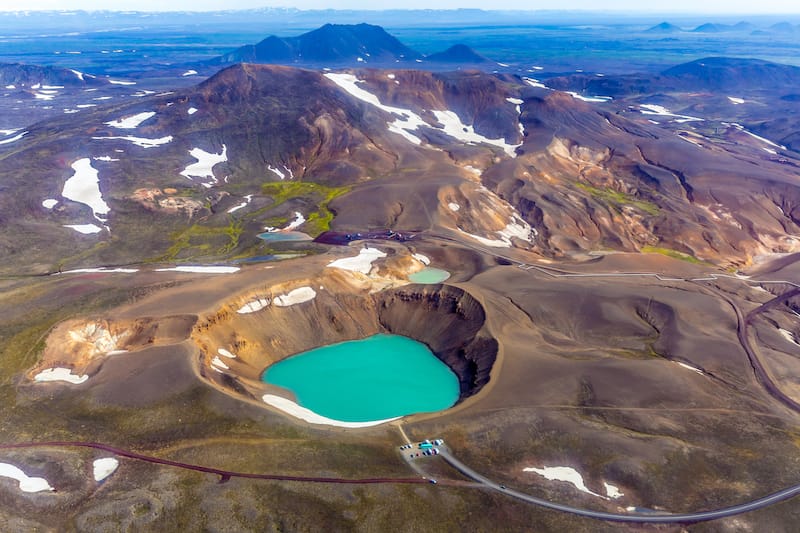
The water is stable at 77F (25C), ideal for swimming in winter and summer.
Víti Maar is accessible throughout the year, but visiting in summer is more recommended to hike around the crater and go down to the moon-like lake. If you are looking for an easy hike, take the right side of the trail.
17. Friðheimar Tomato Farm
Along with many waterfalls, lava fields, glaciers, and canyons, Iceland has Friðheimar Tomato Farm, a renowned place for its fresh tomatoes, horse shows, and friendly atmosphere all year round.
This sustainable business with environmentally friendly practices promotes sustainability and offers exceptionally high-quality natural products.
Friðheimar often organizes horse shows with its six first-prize broodmares. But the most exciting moment is having lunch in the greenhouse.
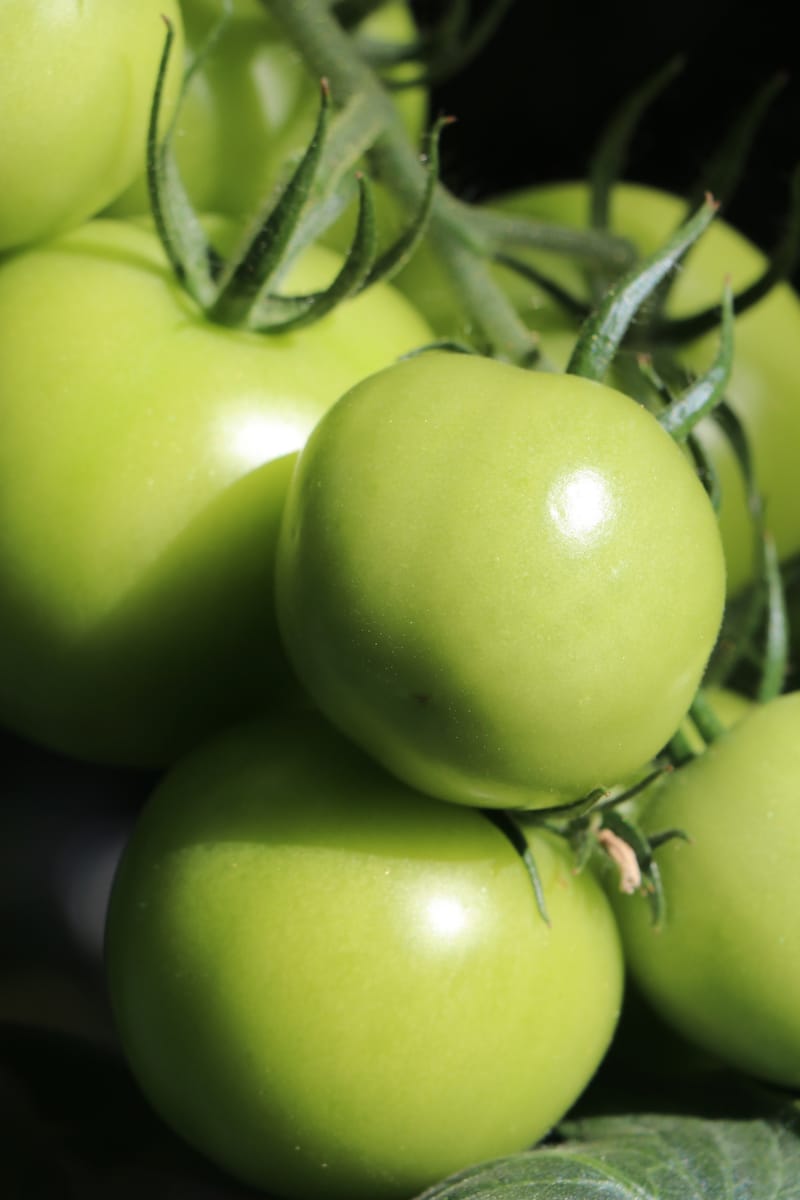
You will be offered tomato soup with freshly baked bread and cucumber salsa. Lunch here is exceptional; that’s why it is offered as a lunch spot on the Golden Circle tour.
After lunch, you can take a tour of greenhouses, learn the techniques of growing tomatoes, and, of course, taste fresh crops.
Before leaving, shop for food souvenirs from the farm made from tomatoes and cucumbers: tomato jam, tomato drinks, and cucumber salsa.
18. Seljavallalaug Pool
Seljavallalaug Pool is one of Iceland’s public geothermal pools surrounded by breathtaking scenery.
It was the very first pool in Iceland built to encourage locals to overcome their fear of water (yes, Icelanders couldn’t swim even though most of them made their living by fishing).
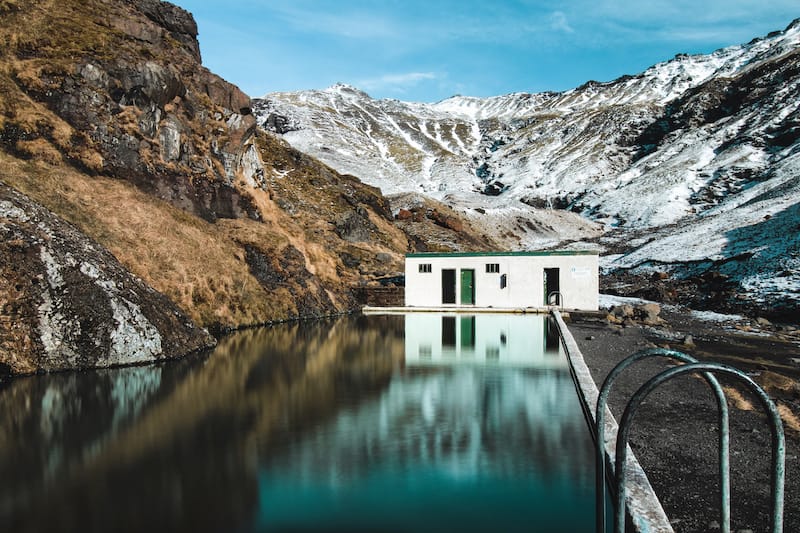
The water in the pool is around 95F (35C), quite comfortable for cool weather to relax and swim, but it gets colder during winter (around 68F, or 20C), and it becomes uncomfortable to stay longer.
Still, swimming in winter means fewer crowds and the northern lights show. Seljavallalaug Pool is part of the Ring Road. It is open 24 hours a day and is free. Don’t forget to pick up your trash and keep the territory clean.
19. Vatnajökull National Park
Vatnajökull National Park is packed with magical scenes, making the national park a must-visit place in Iceland. It is a dream destination for hiking, glacial kayaking, ice-caving, glacier treks, and more.
The national park is huge and is divided into lowlands and remote highlands around the glacier, accessible during the summer. The best way to explore the territory is by hiking.
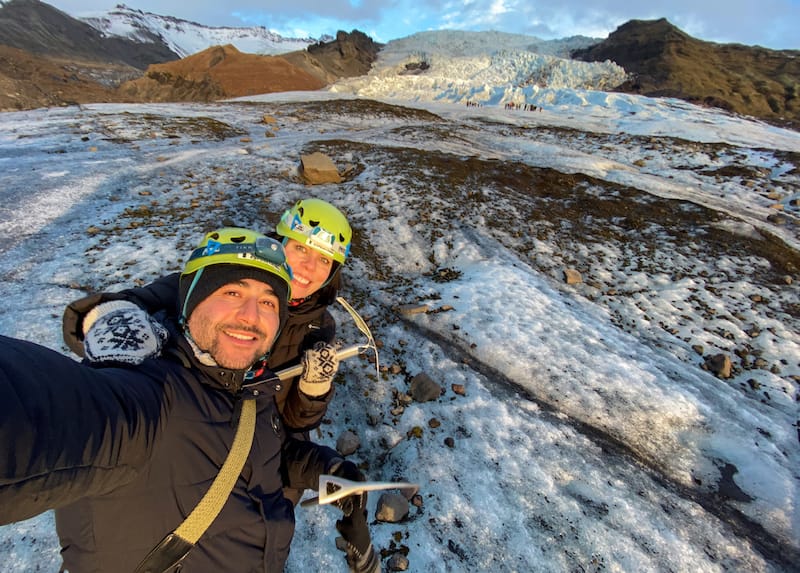
A 1.5-hour trail will take you through the most scenic places of the park straight to Svartifoss waterfall, cascading down the basalt cliffs. Continue the route from the waterfall to the Sjónarnípa viewpoint to see the glacier.
For longer hikes, you can choose Kristínartindar Peaks (about 1 mile, or 1.6 kilometers) or circle the Skaftafellsheiði plateau (4-6 hours of hiking).
Additional Vatnajökull National Park Travel Guides:
20. Hornstrandir Nature Reserve
The dramatic landscapes of Hornstrandir Nature Reserve attract thousands of nature lovers to the Westjords region.
The isolated reserve can be reached by ferry or charter boat from Ísafjörður, so it is reasonable to spend more than one day studying the territory far and wide.
Hornstrandir has mapped hiking trails starting at harbors and taking you to the remote villages and cliffs of Graenahlid. In the summer, Hornstrandir is also a nesting ground for puffins, black guillemots, kittiwakes, Arctic terns, etc.
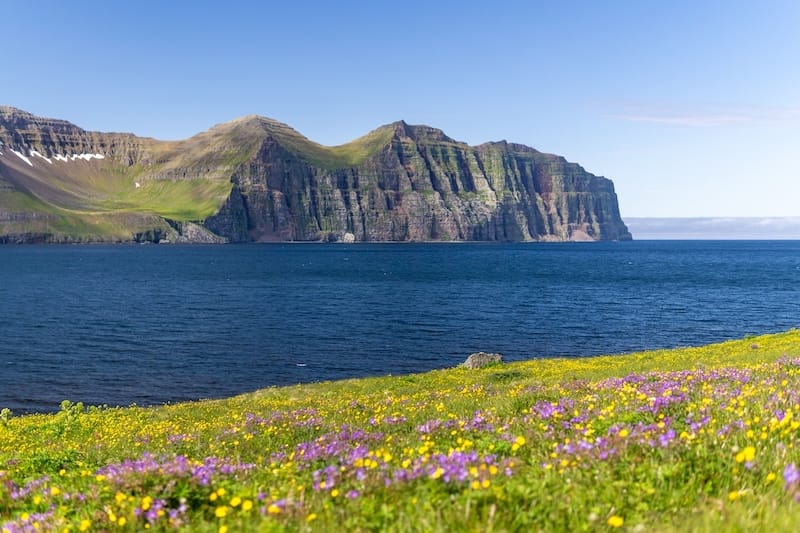
There are not many options for accommodation, but there is a cute Old Doctor’s House cafe, which provides sleeping bags for camping. You will find 13 campsites belonging to the Hornstrandir Environment Agency, but make sure you know everything about camping in the wild.
Keep in mind that there are no shops nearby, so bring plenty of food, water, and warm clothing when visiting Hornstrandir.
21. Húsavík
The small Icelandic town of Húsavík is mostly visited for whale watching, but there are other interesting things not to miss.
The first thing to do in Húsavík is to visit Skjálfandi Bay to watch the common visitors—while-beaked dolphins, humpbacks, and minke whales.
Yet the most impressive is the endangered blue whale also spotted in Húsavík. You can continue exploring whale history on the shores of Iceland in the whale museum.
Also, don’t forget to try local seafood at Gamli Baukur restaurant.
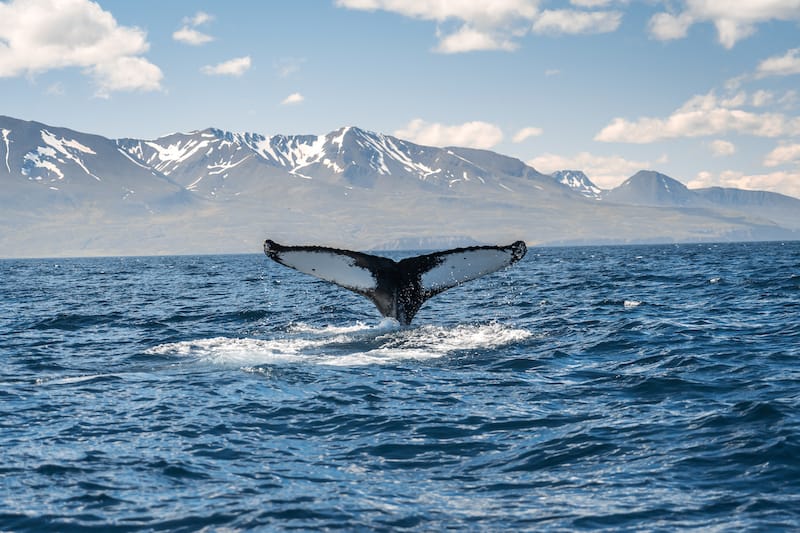
One way to relax after a long day is at the GeoSea Geothermal Sea Baths in Húsavík, with fantastic views of the ocean and Húsavíkurfjall. The spa with open geothermal seawater is built into a cliffside with a bay panorama.
If you plan to visit in July, don’t miss out on the traditional Mærudagar festival, when the whole town is decorated in different colors.
22. The Blue Lagoon
The Blue Lagoon is an absolute favorite in Iceland with its magical milky-blue mineral waters for the most unforgettable bathing experience of your life.
Combine bathing with a sauna, a massage, and a mud mask for a full-day spa treatment.
Once you have enjoyed your time in the spa, visit one of the renowned restaurants at the Blue Lagoon. It can be Moss Restaurant, open only for dinner, or Lava Restaurant, for lunch and dinner.
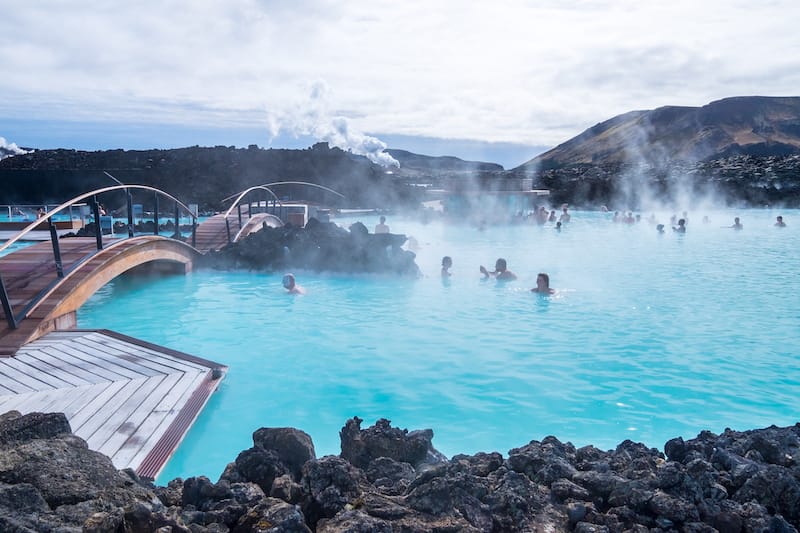
It is a very popular destination among locals and guests, which means there are a lot of people all year round. To avoid crowds, you may visit it early in the morning.
You can check out their website for additional information!
23. Þjórsárdalur Valley
The Þjórsárdalur Valley is a true pearl of nature, brimming with wonders.
Located by the Þjórsá, Iceland’s longest river, the valley takes you to Háifoss, one of the highest waterfalls in the country, neighboring Granni waterfall, Búrfell woods, Þjórsá lava field, and more.
Another location not to miss in the valley is the farmhouse at Stöng, a Viking-age house pictured in the “Wildlings Attack” episode of GOT. Since then, the sight has become even more popular.
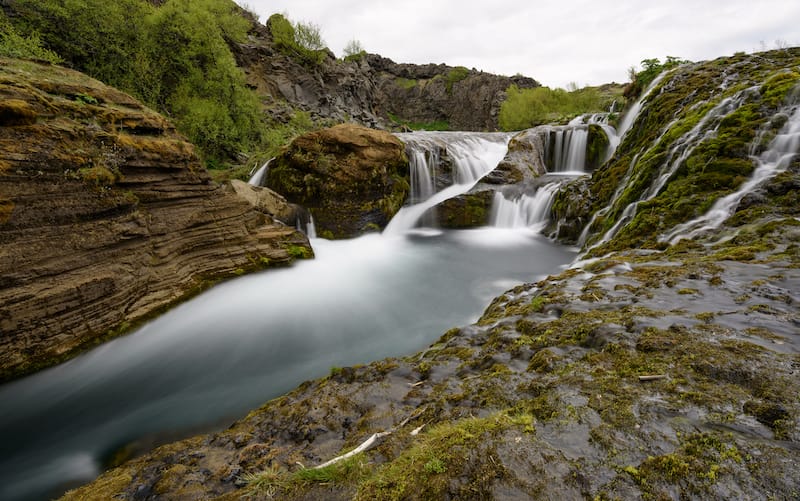
The Þjórsárdalur Valley is ideal for adventure tourism. The sheer cliffs attract rock climbers, but if you are not experienced, you’d better keep your feet on the ground and hike to the Gjáin from Stöng.
A 1.3-mile (2.1-kilometer) hike along steep, heavy rocks will lead straight to a waterfall. The easier trail stretches to the south and leads to lava caves.
24. Seyðisfjörður
The small town of Seyðisfjörður has the highest concentration of historic sites and breathtaking scenery to explore in one day.
Your adventure to the fjord will start with an incredible drive through a high mountain pass, icy lakes, and ice patches before finding a town nestled down in the valley. Seyðisfjörður unique charm is the small traditional houses you have seen in photos.
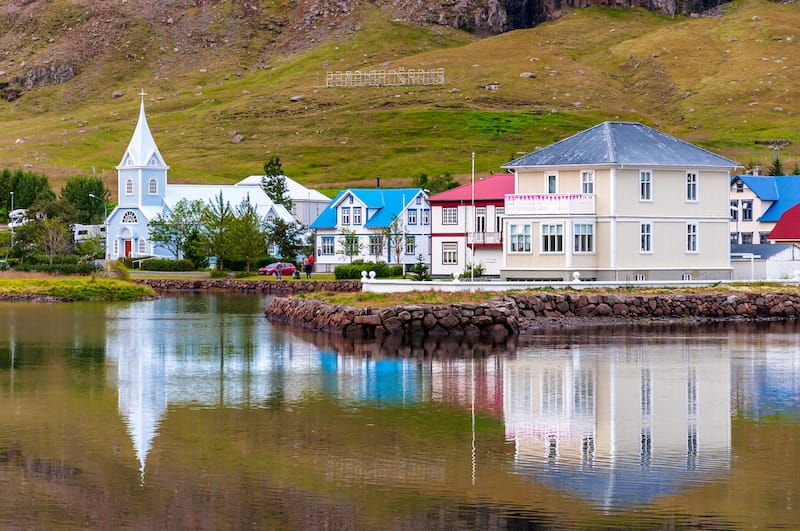
Take your time exploring the streets, seeing the blue church, eating at Nordic Restaurant, and taking the challenging “Seyisfjörur Mountain Viking” hike to see the seven peaks.
To get your name listed in Mountain Vikings, get a map at the visitor center, find containers on each peak, and punch your unique pattern on the container. Before leaving the town, shop for goods from Iceland in the Blóðberg shop.
25. Hengifoss
Hengifoss is the third-tallest waterfall in Iceland (420 feet, or 128 meters) and one of the most popular hiking trails in East Iceland.
The uniqueness of the waterfall lies in the layers of basaltic strata, with red clay layers in between. During the summer, the layers are covered in moss and fossilized trees, making the whole scenery magical.
You will probably visit Hengifoss during your Ring Road tour around the country. From the parking lot, the 1.5-mile (2.5-kilometer) trail will take you up the hill to Hengifoss.
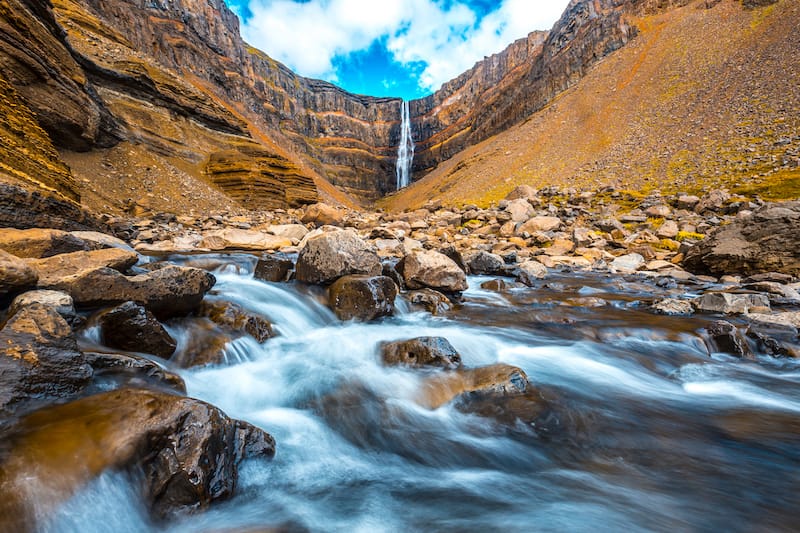
The first stop is a smaller Litlanesfoss waterfall. You will be walking close to the edge to see the hidden waterfall, so be very careful.
In 40 more minutes, you will get to the waterfall. Walk as close as possible to embrace the majesty, but again, watch out for your steps.
26. Raudasandur Beach
Raudasandur Beach in the Westfjords is one more magical destination in Iceland. It is a 6.2-mile (10-kilometer) long beach with red sand. The sand has different shades depending on the weather and daylight.
There are no water sports, beach bars, or entertainment, but Raudasandur is a place you can’t miss.
The beach is surrounded by the tall Látrabjarg cliffs, home to millions of seabirds that nest here from May to September. Bird watching is the main attraction nearby.
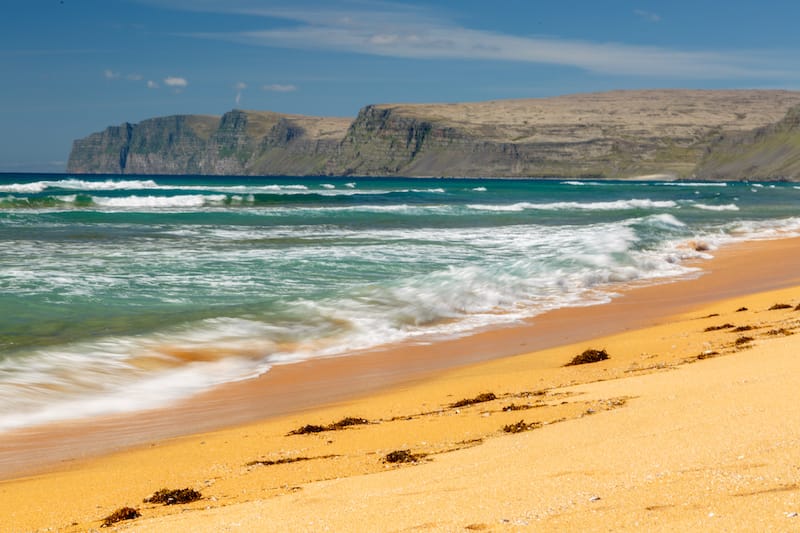
Stay longer on the beach to spot grey or harbor seals or even whales.
Try to plan your visit during a low tide in summer to see the true colors of the red sand beach and enjoy the weather. During the summer, you may also find Franska kaffihúsið open to taste Icelandic waffles.
27. Akureyri
Akureyri is the second-largest settlement in the country, the “Capital of the North,” and the gateway to Iceland’s miraculous natural beauty. Day trips to Akureyri are among the most popular destinations all year round.
The town is all about colorful buildings, street art, and statues of trolls. For local goods, head to Hafnarstræti Street, lined with stores. Akureyri is also known for its hiking trails to Kjarnaskógur Forest.
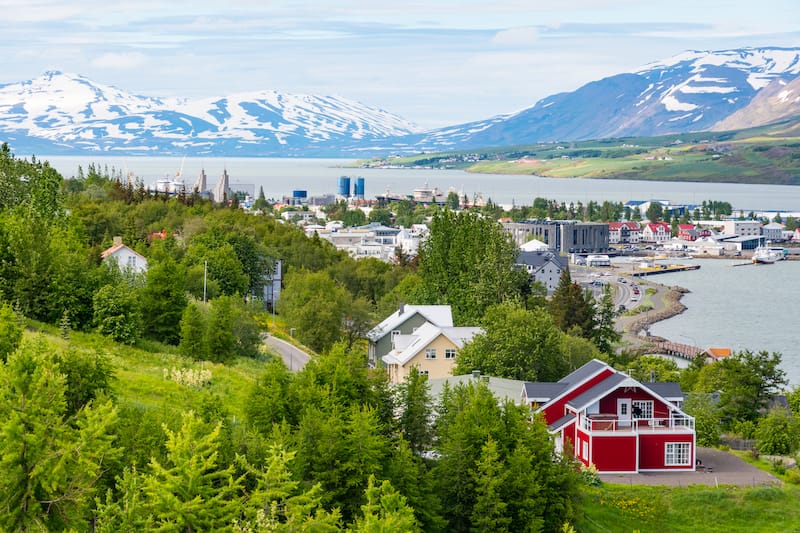
The longest, 7.6-mile (12.2-kilometer) loop trail starts from the city parking lot and takes you deep into the forest to Hamrar campsite. You can either continue elevation to Súlur summit or go back.
If you have time, you can take a boat to Eyjafjord for whale watching. Finally, check out turf homes from the 19th century and buy the best ice cream in Brynjuís.
28. Snaefellsjökull National Park
Snaefellsjökull National Park, with its volcano and glacier, has a shocking diversity of landscapes not to miss.
The very first stop on Snaefellsjökull is the Gerðuberg basalt cliffs, a solid wall of geometric columns. The main attraction of the national park is undoubtedly the Snaefellsjökull sub-glacial volcano.
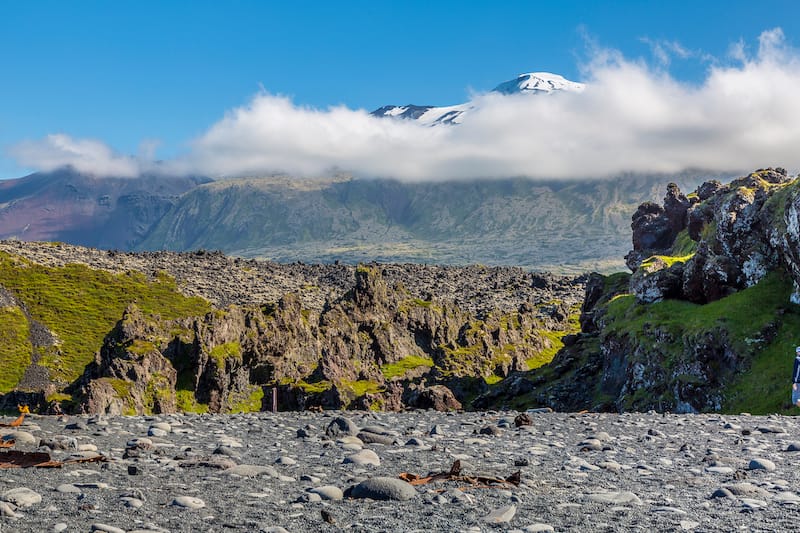
Winter is the best time to visit the glacier because there are no dangers of ice melting and no crowds to detract from your solemnity.
Change the landscapes with ocean views from Lóndrangar Basalt Cliffs and Djúpalónssandur black pebble beach, discover 8000-year-old Vatnshellir Cave, spot seals at Ytri Tunga beach, and take a shot of Búðakirkja black wood church.
29. Gljufrabui Waterfall
There is never enough of Iceland, especially when it comes to hidden beauties like Gljúfrabúi. The name is translated as “one that lives within the canyon.”
The waterfall is hidden between two rocks and is often missed by tourists visiting Seljalandsfoss Waterfall.
To find Gljúfrabúi, you will start with parking near Seljalandsfoss. Make a stop at the majestic 197-foot (60-meter) waterfall from the front. In summer, the territory is covered with moss and wildflowers.
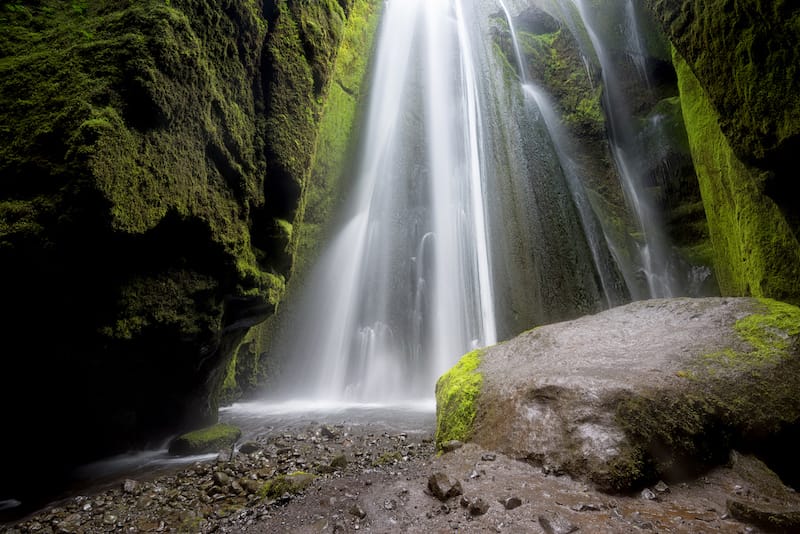
Next, take a 5-minute walk to Gljúfrabúi and find a small opening between the rocks where you can take in the Icelandic waterfall from a different angle.
Step forward carefully as the rocks are slippery, and find the huge rock at the waterfall’s base to stand on and watch the water scattering down.
When you are back in the parking lot, grab a sandwich with hot chocolate at the food trucks and kiss goodbye to Gljúfrabúi.
30. Hjorleifshofdi
Hjorleifshofdi is a volcanic mountain better known for its cave on the headlands. The place and its name refer to important historical events and the early settlers of Iceland.
You can get to Hjorleifshofdi during your Ring Road tour by following the road down the cape. If you want to hike to the cape, take a longer (4.3 miles or 7 kilometers) hike from the Viking settler’s residence.
Don’t be afraid to enter the large cave and check for the intense echoing. By the way, pay attention to the entrance form. It looks like Yoda, and that’s why it is also known as Yoda Cave.
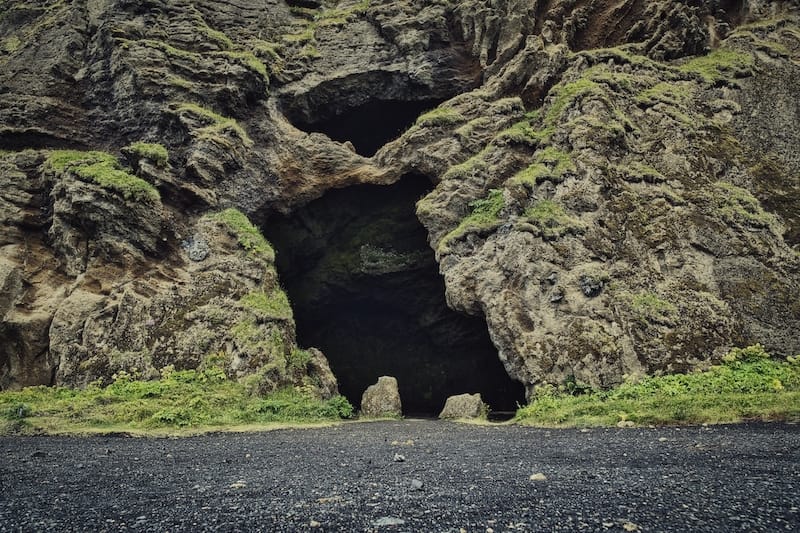
Don’t forget to check out the unreal rock formations to the east of the cave rising in the middle of a valley.
Did I miss any of the best places to visit in Iceland? Let me know your thoughts in the comments!
Places to Visit in Iceland (On a Map!)
More Iceland Travel Guides
- Best waterfalls in Iceland
- Best ATV tour in Iceland
- Silfra snorkeling tours
- Skaftafell Glacier Hiking
- How to Visit the Katla Ice Caves
- Winter in Reykjavik
- Prettiest Iceland beaches
- Small towns in Iceland
- Icelandic Lava Show review
- Westfjords itinerary
- Iceland in April
Pin this Iceland Destinations Guide
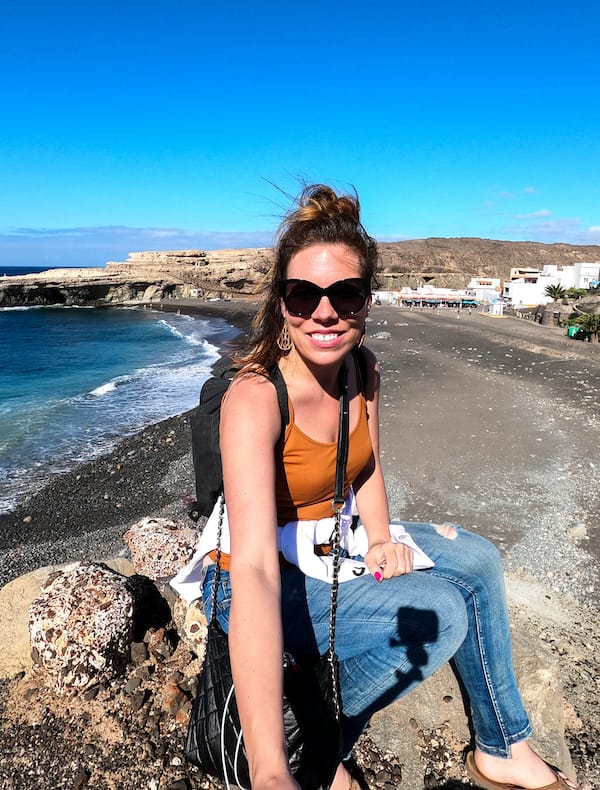
Megan is a travel blogger and writer with a background in digital marketing. Originally from Richmond, VA, she now splits her time between Frankfurt, Germany and Arctic Finland after also living in Norway, Armenia, and Kazakhstan. She has a passion for winter travel, as well as the Nordic countries, but you can also find her eating her way through Italy, perusing perfume stores in Paris, or taking road trips through the USA. Megan has written for or been featured by National Geographic, Forbes, Lonely Planet, the New York Times, and more. She co-authored Fodor’s Travel ‘Essential Norway’ and has visited 45 US states and 100+ countries.

